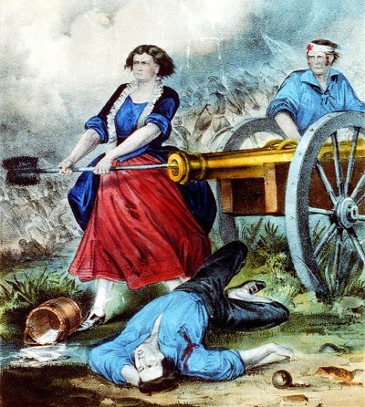There is some debate among historians as to who the “real” Molly Pitcher is. Most believe that the title is a composite character of all of the women who fought in the Continental Army.

Molly Pitcher at the Battle of Monmouth published by Currier & Ives, [between 1856 and 1907] | public domain image
from the Library of Congress Prints and Photographs Division
Mary Ludwig Hays McCauley
The actions of Molly Pitcher are usually attributed to one Mary Ludwig Hays McCauley. (The nickname “Molly” was common for women named “Mary”.) Mary Ludwig was born to a German family in Pennsylvania circa 1744. Details of her childhood are not widely known, though it is believed that her father was a butcher, she had several siblings, and that she was not taught to read or write.
She married William Hays, a foober, in 1769. Hays was a Patriot involved in the 1774 boycott of British goods that arose as protest for the unfair tax being placed on the colonies.
In 1777, Hays enlisted in the Continental Army and was trained as an artilleryman. Mary followed and joined a group of camp followers led by Martha Washington. They took care of the troops, washed clothes, made food, and helped care for the sick or injured soldiers.
In the Battle of Monmouth in June of 1778, Mary Hays carried water from a spring to the thirsty soldiers under heavy fire from the British. When her husband collapsed (sources claim either heat stroke or injury) and was carried off of the battlefield, Mary Hays took his place at his cannon. Once, a cannon ball came so close, that it actually went between her legs, ripping her petticoat. She is only known to have said something along the lines of, “Well, that could have been worse,” and went back to firing her cannon.
The nickname “Molly Pitcher” is believed to have come from the soldiers’ cry, “Molly! Pitcher!” when they were thirsty or when their overheated cannons needed to be cooled down.
We are lucky that a certain Private Joseph Martin thought to record this detail in his journal later on, so the bravery of this woman was not lost to history.
| A woman whose husband belonged to the artillery and who was then attached to a piece in the engagement, attended with her husband at the piece for the whole time. While in the act of reaching a cartridge and having one of her feet as far before the other as she could step, a cannon shot from the enemy passed directly between her legs without doing any other damage than carrying away all the lower part of her petticoat. Looking at it with apparent unconcern, she observed that it was lucky it did not pass a little higher, for in that case it might have carried away something else, and continued her occupation. |
Legend has it that she was thanked personally by General Washington.
After the war, her husband died and she remarried to John McCauley. He spent nearly all of her money and then disappeared. She died at 78.
Margaret Corbin
Others believe that “Molly Pitcher” is really Margaret Corbin, wife of John Corbin who was also an artilleryman in the Continental Army. Her story is very similar to that of Mary Ludwig Hays McCauley.
John Corbin enlisted and Margaret joined a group of camp followers so she could take care of him. In 1776, stationed at Fort Washington, John was killed in the Battle of Fort Washington, leaving his cannon unmanned. Margaret took over and fired his cannon until she was very badly injured. The British won that fight, but they released her as the equivalent of a wounded soldier.
Margaret went to Philadelphia, completely disabled from her wound and unable to work. She is the first woman to receive a government pension as a wounded veteran, though it was not the same amount the men soldiers received.
There are other women, including Deborah Samson, who showed incredible bravery on the battlefield. The legend of “Molly Pitcher” could apply to them just as easily, which is why it is still unclear who Molly Pitcher was.


